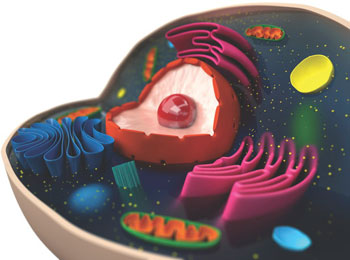 What are you made up of?
Cells make up all living things, including your own body. This picture shows a typical group of cells. But not all cells look alike. Cells can differ in shape and sizes. And the different shapes usually means different functions.
What are you made up of?
Cells make up all living things, including your own body. This picture shows a typical group of cells. But not all cells look alike. Cells can differ in shape and sizes. And the different shapes usually means different functions.
Cells are basic units of structure and function for all living organisms and the structural order in cells forms the basis for properties of life including interaction with environment, movement, energy processing, growth, reproduction and evolution.
Some organisms such as amoebas and most bacteria are single cells while plants and animals are multi-cellular. Humans have an estimated 100 trillion cells and each cell can carry out specialized functions with its own set of instructions stored within the cell for carrying out various activities.
There are two types of cells: eukaryotic and prokaryotic. Prokaryotic cells are usually independent, while eukaryotic cells are usually found in multicellular organisms. Prokaryotes are distinguished from eukaryotes on the basis of nuclear organization, specifically their lack of a nuclear membrane. Nucleus which houses the cell’s chromosomes and is the place where almost all DNA replication and RNA synthesis occurs, gives the eukaryote its name, which means "true nucleus".
Prokaryotes also lack most of the intracellular organelles and structures such as mitochondria, chloroplasts and the Golgi apparatus that are characteristic of eukaryotic cells. All cells have a membrane that envelops the cell, separates its interior from its environment, regulates what moves in and out (selectively permeable) and maintains the electric potential of the cell. All cells possess DNA, the hereditary material of genes; RNA containing the information necessary to build various proteins; and enzymes the cell’s primary machinery. Cells also have a set of "little organs", called organelles, that are adapted and/or specialized for carrying out one or more vital functions. Mitochondria are self–replicating organelles which play a critical role in generating energy in the cell by the process of respiration.
Cell metabolism is the process by which individual cells process nutrient molecules. Metabolism has two distinct divisions: catabolism, in which the cell breaks down complex molecules to produce energy and anabolism in which the cell uses energy to construct complex molecules and perform other biological functions. Cells are capable of synthesizing new proteins, which are essential for the modulation and maintenance of cellular activities. This process involves the formation of new protein molecules from amino acid building blocks based on information encoded in DNA/RNA.